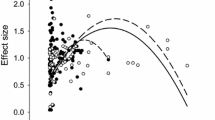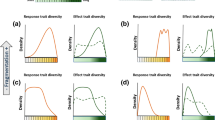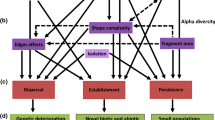Abstract
Context
Ecological processes that shape diversity and spatial pattern of ecological communities are often altered by disturbance. Spatial patterns (spatial autocorrelation) in species diversity are thus expected to change with disturbance.
Objective
When examining spatial patterns, ecologists traditionally lump positive and negative spatial autocorrelation into the overall spatial autocorrelation. By contrast, here we aim to understand disturbance effects on both positive and negative spatial autocorrelation of species richness and evenness, which may be related to environmental filtering and restricted dispersal, and to competition, respectively.
Methods
For 8 years, we monitored the spatial autocorrelation in species richness and evenness of riparian plant communities in both uncut control and experimentally clearcut sites in the boreal forest of Alberta, Canada. The overall spatial autocorrelation for each of these two indices of diversity was separately decomposed into the components of positive and negative spatial autocorrelations through eigendecomposition of the spatial weighting matrix.
Results
Negative spatial autocorrelation in richness and evenness were more pronounced in the clearcut than uncut sites, although positive spatial autocorrelations in all indices of diversity remained unchanged. Effect of disturbance was not detected on the overall spatial autocorrelation.
Conclusions
Disturbance increases negative spatial autocorrelation in species richness and evenness, with a stronger increase in evenness than richness, which underscores the importance of competition in structuring post-disturbance riparian communities. Our results also highlight the need for assessing positive and negative spatial autocorrelation and different aspects of diversity separately in understanding disturbance effects on the spatial pattern, or identifying processes from patterns.



Similar content being viewed by others
References
Adler PB, Raff DA, Lauenroth WK (2001) The effect of grazing on the spatial heterogeneity of vegetation. Oecologia 128(4):465–479
Anselin L (1995) Local Indicators of Spatial Association—LISA. Geogr Anal 27(2):93–115
Bartz KK, Naiman RJ (2005) Effects of salmon-borne nutrients on riparian soils and vegetation in southwest Alaska. Ecosystems 8(5):529–545
Bestelmeyer BT, Goolsby DP, Archer SR (2011) Spatial perspectives in state-and-transition models: a missing link to land management? J Appl Ecol 48(3):746–757
Bever JD, Richardson SC, Lawrence BM, Holmes J, Watson M (2009) Preferential allocation to beneficial symbiont with spatial structure maintains mycorrhizal mutualism. Ecol Lett 12(1):13–21
Biswas SR, Mallik AU (2010) Disturbance effects on species diversity and functional diversity in riparian and upland plant communities. Ecology 91(1):28–35
Biswas SR, Mallik AU (2011) Species diversity and functional diversity relationship varies with disturbance intensity. Ecosphere 2(4), Article 52
Biswas SR, Mallik AU, Braithwaite NT, Wagner HH (2016) A conceptual framework for the spatial analysis of functional trait diversity. Oikos 125(2):192–200
Biswas SR, Wagner HH (2012) Landscape contrast: a solution to hidden assumptions in the metacommunity concept? Landscape Ecol 27(5):621–631
Bivand RS, Edzer P, Gómez-Rubio V (2013) Applied spatial data analysis with R. Springer, New York
Braithwaite NT, Mallik AU (2012) Edge effects of wildfire and riparian buffers along boreal forest streams. J Appl Ecol 49(1):192–201
de Jong P, Sprenger C, van Veen F (1984) On extreme values of Moran’s I and Geary’s c. Geogr Anal 16(1):17–24
Deleglise C, Loucougaray G, Alard D (2011) Spatial patterns of species and plant traits in response to 20 years of grazing exclusion in subalpine grassland communities. J Veg Sci 22(3):402–413
Dombois DM, Ellenberg H (1974) Aims and methods of vegetation ecology. Wiley, New York
Dray S (2011) A new perspective about Moran’s coefficient: spatial autocorrelation as a linear regression problem. Geogr Anal 43(2):127–141
Dray S, Legendre P, Peres-Neto PR (2006) Spatial modelling: a comprehensive framework for principal coordinate analysis of neighbour matrices (PCNM). Ecol Model 196(3–4):483–493
Dray S, Pelissier R, Couteron P, Fortin MJ, Legendre P, Peres-Neto PR, Bellier E, Bivand R, Blanchet FG, De Cáceres M, Dufour AB (2012) Community ecology in the age of multivariate multiscale spatial analysis. Ecol Monogr 82(3):257–275
Duthie AB, Falcy MR (2013) The influence of habitat autocorrelation on plants and their seed-eating pollinators. Ecol Model 251:260–270
Fortin MJ, Dale MRT (2005) Spatial analysis: a guide for ecologists. Cambridge University Press, Cambridge
Franklin JF, Forman RTT (1987) Creating landscape patterns by forest cutting: ecological consequences and principles. Landscape Ecol 1(1):5–18
Fraterrigo JM, Rusak JA (2008) Disturbance-driven changes in the variability of ecological patterns and processes. Ecol Lett 11(7):756–770
Halpern CB, Lutz JA (2013) Canopy closure exerts weak controls on understory dynamics: a 30-year study of overstory-understory interactions. Ecol Monogr 83(2):221–237
Harper KA, Macdonald SE (2002) Structure and composition of edges next to regenerating clear-cuts in mixed-wood boreal forest. J Veg Sci 13(4):535–546
Harper KA, Macdonald SE, Mayerhofer MS, Harper KA, Macdonald SE, Mayerhofer MS, Biswas SR, Esseen PA, Hylander K, Stewart KJ, Mallik AU, Drapeau P, Jonsson BG, Lesieur D (2015) Edge influence on vegetation at natural and anthropogenic edges of boreal forests in Canada and Fennoscandia. Journal of Ecology 103(3):550–562
Hutchinson GE (1959) Homage to Santa Rosalia or why are there so many kinds of animals? Am Nat 93(870):145–159
Krebs CJ (1999) Ecological methodology. Pearson Education, Upper Saddle River
Kunte K (2008) Competition and species diversity: removal of dominant species increases diversity in Costa Rican butterfly communities. Oikos 117(1):69–76
Legendre P (1993) Spatial autocorrelation: trouble or new paradigm. Ecology 74(6):1659–1673
Legendre P, Fortin MJ (1989) Spatial pattern and ecological analysis. Vegetatio 80(2):107–138
Ma M (2005) Species richness vs evenness: independent relationship and different responses to edaphic factors. Oikos 111(1):192–198
MacArthur RH (1957) On the relative abundance of bird species. Proc Natl Acad Sci USA 43(3):293–295
MacDonald RL, Chen HYH, Bartels SF, Palik BJ, Prepas EE (2015) Compositional stability of boreal understorey vegetation after overstorey harvesting across a riparian ecotone. J Veg Sci 26(4):733–741
MacDonald RL, Chen HYH, Palik BJ, Prepas EE (2014) Influence of harvesting on understory vegetation along a boreal riparian-upland gradient. For Ecol Manag 312:138–147
Mallik AU, Newaz S, Mackereth RW, Shahi C (2011) Geomorphic changes of headwater systems 3-23 years after forest harvesting by clearcutting. Ecosphere 2(4):1
Martin LM, Moloney KA, Wilsey BJ (2005) An assessment of grassland restoration success using species diversity components. J Appl Ecol 42(2):327–336
Mayfield MM, Bonser SP, Morgan JW, Aubin I, McNamara S, Vesk PA (2010) What does species richness tell us about functional trait diversity? Predictions and evidence for responses of species and functional trait diversity to land-use change. Glob Ecol Biogeogr 19(4):423–431
McGill BJ (2010) Matters of scale. Science 328(5978):575–576
McIntire EJB, Fajardo A (2009) Beyond description: the active and effective way to infer processes from spatial patterns. Ecology 90(1):46–56
Meyers LM, DeKeyser ES, Norland JE (2014) Differences in spatial autocorrelation (SAc), plant species richness and diversity, and plant community composition in grazed and ungrazed grasslands along a moisture gradient, North Dakota, USA. Appl Veg Sci 17(1):53–62
Moran PAP (1948) The interpretation of statistical maps. J R Stat Soc Ser B 10(2):243–251
Munkemuller T, de Bello F, Meynard CN, Gravel D, Lavergne S, Mouillot D, Mouquet N, Thuiller W (2012) From diversity indices to community assembly processes: a test with simulated data. Ecography 35(5):468–480
Naiman RJ, Bechtold JS, Drake DC, Latterell JJ, O’Keefe TC, Balian EV (2005) Origins, patterns, and importance of heterogeneity in riparian systems. In: Lovett GM, Jones CG, Turner MG, Weathers KC (eds) Ecosystem function in heterogeneous landscapes. Springer, New York, pp 279–309
Naiman RJ, Decamps H (1997) The ecology of interfaces: riparian zones. Annu Rev Ecol Syst 28:621–658
Nilsson C, Svedmark M (2002) Basic principles and ecological consequences of changing water regimes: riparian plant communities. Environ Manag 30:468–480
Palmer MW (1994) Variation in species richness: towards a unification of hypotheses. Folia Geobot Phytotaxon 29(4):511
Pielou EC (1969) Ecological diversity and it’s measurement: an introduction to mathematical ecology. Wiley, Toronto
Pottier J, Bedecarrats A, Marrs RH (2009) Analysing the spatial heterogeneity of emergent groups to assess ecological restoration. J Appl Ecol 46(6):1248–1257
Roe CM, Parker GC, Korsten AC, Lister CJ, Weatherall SB, Lodge L, Rachael HE, Bastow Wilson J (2012) Small-scale spatial autocorrelation in plant communities: the effects of spatial grain and measure of abundance, with an improved sampling scheme. J Veg Sci 23(3):471–482
Sokal RR (1979) Testing statistical significance of geographic variation patterns. Syst Biol 28(2):227–232
Thuiller W, Gueguen M, Georges D, Bonet R, Chalmandrier L, Garraud L, Renaud J, Roquet C, Van Es J, Zimmermann NE, Lavergne S (2014) Are different facets of plant diversity well protected against climate and land cover changes? A test study in the French Alps. Ecography 37(12):1254–1266
Tiefelsdorf M, Griffith DA, Boots B (1999) A variance-stabilizing coding scheme for spatial link matrices. Environ Plan A 31(1):165–180
Tobler WR (ed) (1975) Linear operators applied to areal data. Wiley, London
Turner MG (1989) Landscape ecology: the effect of pattern on process. Annu Rev Ecol Syst 20:171–197
Turner MG (2010) Disturbance and landscape dynamics in a changing world. Ecology 91(10):2833–2849
Wagner HH (2013) Rethinking the linear regression model for spatial ecological data. Ecology 94(11):2381–2391
Wagner HH, Fortin MJ (2005) Spatial analysis of landscapes: concepts and statistics. Ecology 86(8):1975–1987
Watt AS (1947) Pattern and process in the plant community. J Ecol 35:1–22
White PS, Jentsch A (2001) The search for generality in studies of disturbance and ecosytems dynamics. Prog Bot 62:399–449
Whittaker RH (1972) Evolution and measurement of species diversity. Taxon 21:213–251
Wiens JA (1989) Spatial scaling in ecology. Funct Ecol 3(4):385–397
Wilsey B, Stirling G (2007) Species richness and evenness respond in a different manner to propagule density in developing prairie microcosm communities. Plant Ecol 190(2):259–273
Wilsey BJ, Chalcraft DR, Bowles CM, Willig MR (2005) Relationships among indices suggest that richness is an incomplete surrogate for grassland biodiversity. Ecology 86(5):1178–1184
Wilsey BJ, Potvin C (2000) Biodiversity and ecosystem functioning: importance of species evenness in an old field. Ecology 81(4):887–892
Wilson JB, Meurk CD (2011) The control of community composition by distance, environment and history: a regional-scale study of the mountain grasslands of southern New Zealand. J Biogeogr 38(12):2384–2396
With KA, King AW (2001) Analysis of landscape sources and sinks: the effect of spatial pattern on avian demography. Biol Conserv 100(1):75–88
Zhang Y, Chen HYH, Reich PB (2012) Forest productivity increases with evenness, species richness and trait variation: a global meta-analysis. J Ecol 100(3):742–749
Acknowledgements
This study was part of the National Science and Engineering Research Council (NSERC), Canada funded CRD project ‘FORWARD’ and partners (http://forward.lakeheadu.ca/). We thank Kirk Moloney, MSI Khan and three anonymous reviewers for their constructive comments on earlier versions of this manuscript.
Author information
Authors and Affiliations
Corresponding author
Electronic supplementary material
Below is the link to the electronic supplementary material.
Rights and permissions
About this article
Cite this article
Biswas, S.R., MacDonald, R.L. & Chen, H.Y.H. Disturbance increases negative spatial autocorrelation in species diversity. Landscape Ecol 32, 823–834 (2017). https://doi.org/10.1007/s10980-017-0488-9
Received:
Accepted:
Published:
Issue Date:
DOI: https://doi.org/10.1007/s10980-017-0488-9




